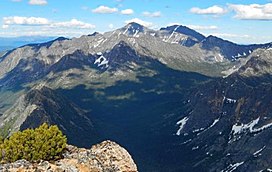이치리즈카
Ichirizuka
이치리즈카(一里塚)는 이정표와 유사한 일본의 역사적인 거리표지판이다.나무로 덮인 흙무더기(츠카 또는 주카) 한 쌍으로 구성되어 1603년 에도에 세워진 '일본의 다리' 니혼바시까지의 거리를 3.927km(2.440mi)로 표시하였다.[3]이치리즈카는 엥겔베르트 켐페르(C.1690)가 만나 다음과 같이 기술하였다. " 이정표로서의 봉사는 두 언덕으로, 서로 마주보고, 도로 양쪽에 세워져 있고, 하나 이상의 나무가 심어져 있다."[4][note 1]
설립
도쿠가와 막부는 1604년에 주요 도로에 이치리즈카를 설치하여, 이동 거리 및 카고나 가마로 운송료를 계산할 수 있게 되었다.[5]"우체국과 지방 마을"이 유지하기로 되어 있는 이 사냥개들은 다리와 여객선, 우체국(두 곳 모두 슈쿠바, 그리고 더 비공식적인 ai노슈쿠), 찻집(차야)도 포함하는 개발 도로 인프라의 한 구성요소였다.[6]그러나, 주된 목적은 "휴양 여행이 아닌 공식적인 이동성"이었다: 농부들과 여성들의 움직임이 위축되었고, 여권과 장벽 (関所) 시스템이 유지되었다.[6]교토보다는 에도에서 거리를 표시함으로써,
도쿠가와는 모든 운동의 상징적인 기원을 확립하면서, 나중에 체크포인트를 만들었는데, 이것은 정부의 지정학적 편재성을 강력하게 일깨워주고 우주에 대한 전용에 효과적인 도구라는 것이다.[3]
이치리즈카는 인쇄업자 히시카와 모로노부(d. 1694년)의 잘 알려진 「도카이도의 비례 지도」에서 찾아볼 수 있을 정도로 중요했다.[7]전통시는 거리를 표시하는 이치리즈카를 사람의 수년을 표시하는 가도마쓰에 비유한다.[8]
서바이벌
메이지 시대에 일본의 근대화로 많은 군락이 도로 확장과 건설 계획을 통해 사라졌으며, 현재는 둘 다 생존하는 경우가 드물다.[9][10]현존하는 이치리즈카 중 16개는 국가사적지로서 보호를 위해 지정되었다.[11]도쿄에 있는 두 사람 중 니시가하라에서 한때 도로확장사업으로 위협을 받았던 사람; '일본 자본주의의 아버지' 시부사와 에이이치씨가 주도한 그것을 구하기 위한 운동은, 지금의 홍고도리(本高道里)[5][12] 옆에 있는 기념비에 기념되어 있다.(35°44′50″N 139°44′28″E / 35.74714731°N 139.74111289°E/ (
참고 항목
| 위키미디어 커먼즈에는 이치리즈카와 관련된 미디어가 있다. |
메모들
- ^ "Zu einem Meilenzeichen dienn zween gegen einander steende Huzel, Welche zu Beiden Seiten des Weges aufges ohr Baumen bepflanzt sd" (Geschicht und und.
참조
- ^ "垂井一里塚" [Tarui Ichirizuka]. Gifu Prefecture. Retrieved 3 July 2012.
- ^ "Shöno (Station #46)". Honolulu Museum of Art. Retrieved 3 July 2012.
- ^ a b Nenzi, Laura (2008). Excursions in Identity: Travel and the Intersection of Place, Gender, and Status in Edo Japan. University of Hawaii Press. pp. 21–22. ISBN 978-0-824-83117-2.
- ^ "History of Japanese Roads". Ministry of Land, Infrastructure, Transport and Tourism. Archived from the original on 24 April 2009. Retrieved 3 July 2012.
- ^ a b "Tokyo Cultural Properties Database: Nishigahara Ichirizuka". Tokyo Metropolitan Government. Retrieved 3 July 2012.[영구적 데드링크]
- ^ a b Traganou, Jilly (2004). The Tōkaidō Road: Traveling and representation in Edo and Meiji Japan. Routledge. pp. 14–15. ISBN 0-415-31091-1.
- ^ Vaporis, Constantine N. (2012). "Linking the Realm: The Gokaido Highway Network in Early Modern Japan (1603-1868)". In Susan E. Alcock (ed.). Highways, Byways, and Road Systems in the Pre-Modern World. John Bodel, Richard J.A. Talbert. John Wiley & Sons. pp. 90–105. ISBN 9780470674253. Retrieved 25 July 2012.
- ^ Joly, Henry L. (1908). Legend in Japanese Art. London: John Lane. pp. 274–75. ISBN 9781440083921.
- ^ "Historical and Cultural Monuments - Ano Ichirizuka". Toyoake City. Archived from the original on 8 August 2011. Retrieved 3 July 2012.
- ^ "Tokyo Cultural Properties Database: Shimura Ichirizuka". Tokyo Metropolitan Government. Retrieved 3 July 2012.[영구적 데드링크]
- ^ "Database of National Cultural Properties (search term: 一里塚)" (in Japanese). Agency for Cultural Affairs. Archived from the original on 4 December 2015. Retrieved 3 July 2012.
- ^ "二本榎保存之碑" [Japanese Hackleberry Preservation Stele] (in Japanese). Kita Ward. Archived from the original on 25 May 2010. Retrieved 3 July 2012.



